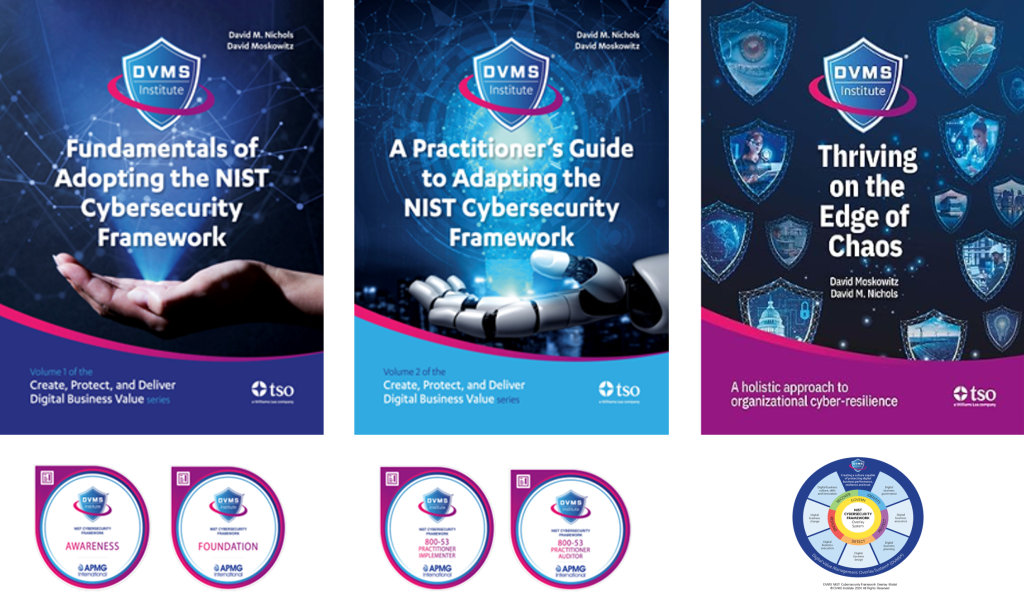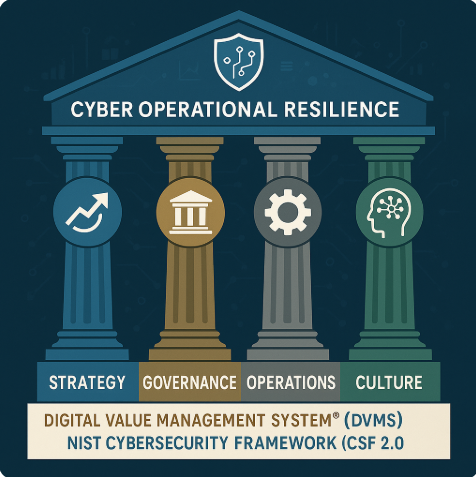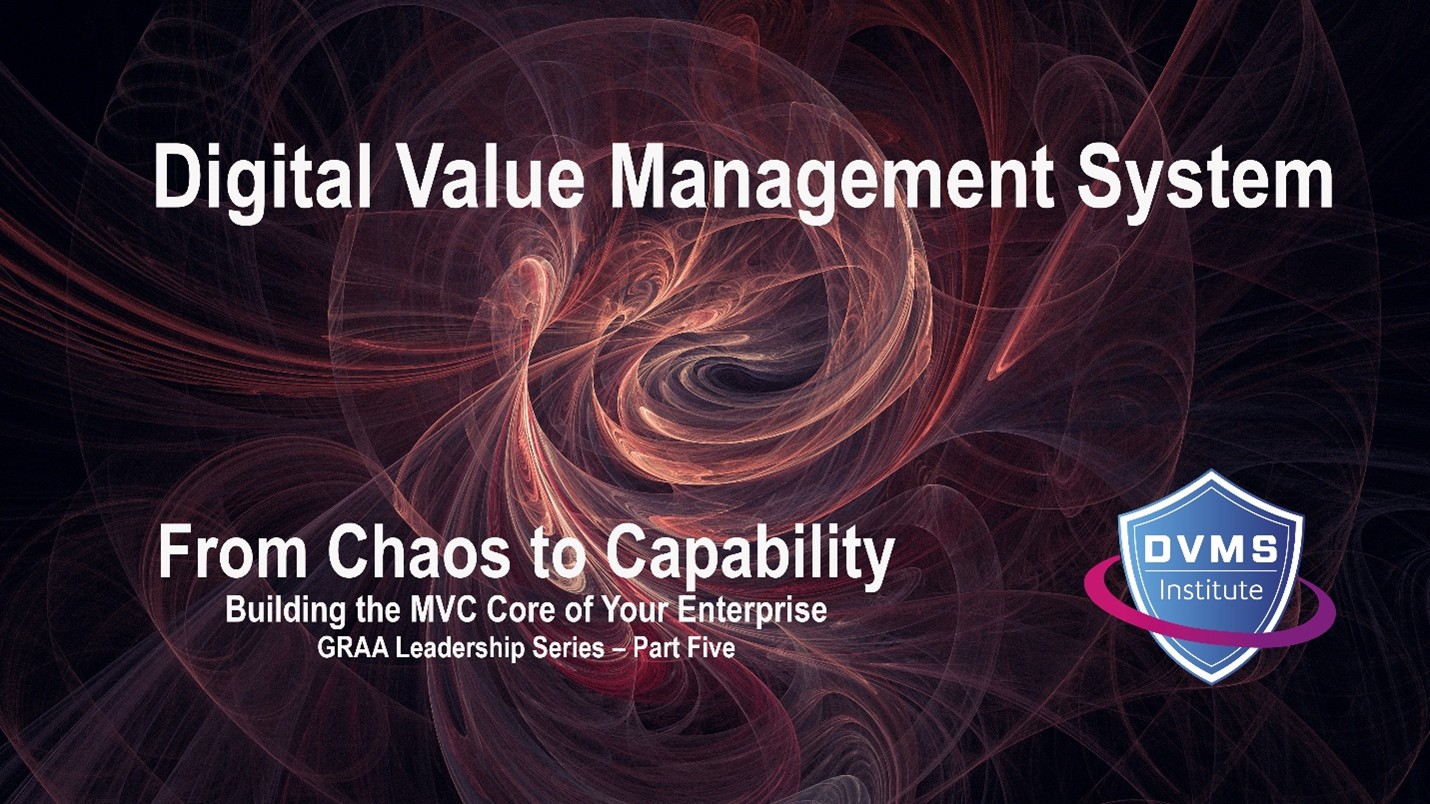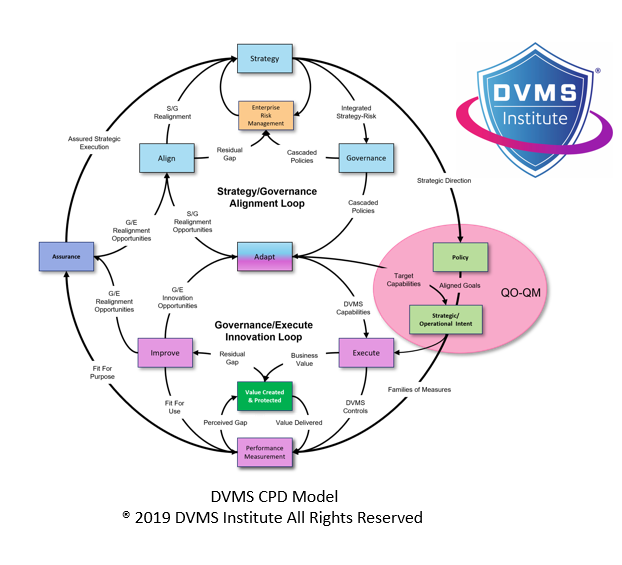The Power of Alignment: Strategy, Governance, Operations, and Culture as Pillars of Cyber Operational Resilience
Rick Lemieux – Co-Founder and Chief Product Officer of the DVMS Institute
Cyber operational resilience has become a cornerstone of sustainable success in the digital age, where threats evolve faster than defenses and value creation increasingly depend on technology. Organizations face relentless cyber threats that are no longer limited to technology breakdowns but encompass disruptions to trust, brand reputation, compliance, and business continuity.
Against this backdrop, aligning organizational strategy, governance, operations, and culture is beneficial and imperative. Cyber operational resilience cannot be achieved through isolated functions or reactive defenses. Instead, it must be intentionally built into an organizational DNA through integrated and aligned capabilities. The NIST Cybersecurity Framework (CSF) 2.0 and the Digital Value Management System® (DVMS) provide a comprehensive foundation for this alignment, reinforcing the idea that cybersecurity is a strategic enabler of digital value, not merely a technical problem to be solved.
Strategic Intent and Risk Integration
At the heart of any resilient organization lies a coherent strategy. However, strategic planning without integrating risk is incomplete in today’s volatile threat environment. The DVMS introduces the concept of “strategy-risk,” a unification of strategic objectives and risk management that reframes cybersecurity as an intrinsic element of value creation. This approach helps organizations avoid the common failure of treating security as a compliance checkbox or an afterthought, which results in brittle, reactive defenses. Instead, the strategic alignment ensures that cybersecurity objectives are embedded in business priorities from the outset. In this model, digital business value is created and protected concurrently—a shift from the outdated “create, then secure” mentality.
The NIST CSF 2.0 reinforces this strategic integration through the “Govern” function, which elevates the role of cybersecurity governance and mandates that organizations define and monitor cybersecurity expectations within the broader context of enterprise risk management. In this framework, governance becomes a strategic instrument, not just a control mechanism. It ensures alignment between business goals, digital risks, and security investments, creating a foundation for resilience that can evolve alongside changing threats and business models.
Governance as the Anchor of Accountability
Effective governance structures are essential to implementing and sustaining cyber resilience. Governance defines the organizational roles, responsibilities, and authorities and enforces risk-informed policies and oversight. The DVMS characterizes governance as one of its seven minimum viable capabilities (MVCs), recognizing that even the best strategies will falter without clarity and accountability. Governance must be driven from the top, through boards and senior executives who understand their fiduciary responsibility to safeguard digital value and ensure business continuity.
Moreover, governance enables decision-making informed by organizational priorities and contextual risk. The NIST CSF 2.0, through its Tiers and Profiles, allows organizations to assess the maturity of their cybersecurity governance and align their posture to the level of risk tolerance appropriate for their industry, mission, and scale. Profiles support transparency in communicating current and target cybersecurity states internally and with external stakeholders. This structured self-awareness is essential for coordinating efforts across business units, reducing redundancies, and identifying gaps that could undermine resilience.
Operational Execution as a System of Systems
Operations are the engine room of resilience. It is not enough to define a strategy and govern its execution—the organization must be able to operationalize resilience through its people, processes, and technologies. The DVMS frames organizations as “systems of systems,” emphasizing that resilience requires interconnected and adaptive operational practices. Capabilities such as Plan, Design, Execute, and Change work together to ensure that cybersecurity controls are not just deployed but are sustainable, auditable, and continuously improving.
Operational alignment demands that cybersecurity is integrated across workflows rather than siloed within IT departments. This includes secure-by-design principles, proactive incident response plans, and ongoing vulnerability assessments embedded in day-to-day functions. The NIST CSF Core outlines this clearly through its six functions: Govern, Identify, Protect, Detect, Respond, and Recover. These functions are not sequential—they must operate simultaneously, reinforcing one another to manage threats effectively and recover rapidly when incidents occur. For example, detection investments are useless without transparent governance and response protocols. Operational excellence in resilience, therefore, hinges on cross-functional alignment, process rigor, and automation informed by real-time risk intelligence.
Culture as the Invisible Backbone
Perhaps the most underestimated but critical dimension of cyber resilience is organizational culture. Culture expresses how people behave, make decisions, and perceive their role in protecting values. A resilient organization fosters a culture of accountability, transparency, and continual learning. As the DVMS asserts, culture is not a vague concept—it is a strategic asset that leadership must actively shape through consistent behavior, communication, and recognition systems.
The CSF 2.0 acknowledges the influence of culture by embedding it into its Govern function and encouraging organizations to consider cultural factors in defining roles and responsibilities. For instance, embedding security moments in regular meetings, conducting cross-functional tabletop exercises, and rewarding secure behavior are cultural practices that reinforce resilience. Organizations that normalize security awareness and cross-functional collaboration reduce the risk of insider threats and foster faster, more coordinated responses to incidents.
Importantly, culture also determines how quickly and effectively organizations adapt to change. As the DVMS notes, cultural transformation is akin to steering a supertanker—slow, deliberate, and requiring persistence. Yet once momentum is built, it becomes a self-sustaining force for resilience. Cultural alignment ensures that cybersecurity’s strategic and operational imperatives are not resisted but embraced across all enterprise levels.
The Synergy of Alignment
The alignment of strategy, governance, operations, and culture creates a reinforcing loop that propels organizations toward higher levels of cyber resilience. Strategic clarity ensures that resources are allocated to the most critical risks. Governance structures provide the oversight and accountability needed to enforce security practices. Operational integration ensures that those practices are executed effectively and adapted as required. And cultural alignment ensures that all these efforts are supported and sustained by the organization’s people.
The DVMS and NIST CSF provide a practical framework for this alignment. Together, they emphasize that cyber resilience is not a technology initiative but a business capability. It is achieved not through isolated functions but through the continuous, coordinated effort of all parts of the organization working toward a common objective: to create, protect, and deliver digital business value in the face of adversity.
Conclusion: Thriving in a Digital World
In a world where cyber incidents are inevitable, resilience is not a luxury but a necessity. Organizations that align their strategy, governance, operations, and culture will survive disruptions and thrive on the edge of chaos. This alignment transforms cybersecurity from a defensive function into a catalyst for innovation, trust, and competitive advantage. With frameworks like NIST CSF and models like the DVMS, organizations can move from reactive risk management to proactive, adaptive resilience, where value is protected and continually delivered and improved.
About the Author

Rick Lemieux
Co-Founder and Chief Product Officer of the DVMS Institute
Rick has 40+ years of passion and experience creating solutions to give organizations a competitive edge in their service markets. In 2015, Rick was identified as one of the top five IT Entrepreneurs in the State of Rhode Island by the TECH 10 awards for developing innovative training and mentoring solutions for boards, senior executives, and operational stakeholders.
In today’s digitally driven economy, cyber disruptions are no longer an “if” but a “when.”
The DVMS Institute’s Certified Training Programs teach organizations the skills to turn static and fragmented digital Governance, Risk, and Compliance (GRC) into an Integrated and Adaptive Digital Value Management System® capable of driving Cyber Operational Resilience, Regulatory Compliance, and Digital Trust business outcomes.
The DVMS powers this adaptive and integrated management system using existing best practice frameworks and standards (NIST, ISO, ITSM, GRC etc.) operationalized by the DVMS MVC, CPD, and 3D Knowledge models to deliver resilient, compliant, and trusted business outcomes

Enabling an integrated and adaptive GRC system requires seamless alignment across organizational Strategy, Governance, and Operations, with active engagement from all members of a Digital Ecosystem. Each member plays a distinct role in proactively identifying and mitigating the systemic risks that threaten digital business operations.
This forward-looking approach to Integrated and Adaptive Governance, Risk, and Compliance positions businesses to:
- Maintain Operational Stability Amidst Constant Digital Disruption
- Drive Agility and Trust Across Your Digital Ecosystem
- Satisfy Critical Regulatory and Certification Requirements
- Leverage Cyber Resilience as a Competitive Advantage
DVMS Explainer Videos
- Architecture Video: David Moskowitz explains the DVMS System
- Case Study Video: Dr. Joseph Baugh Shares His DVMS Story.
- Overlay Model – What is an Overlay Model
- ZX Model – The MVC’s that power operational resilience
- CPD Model – Adaptable governance and assurance
- 3D Knowledge Model – Enabling holistic organizational learning
- FastTrack Model – A phased approach to cyber resilience
Digital Value Management System® is a registered trademark of the DVMS Institute LLC.
® DVMS Institute 2025 All Rights Reserved




